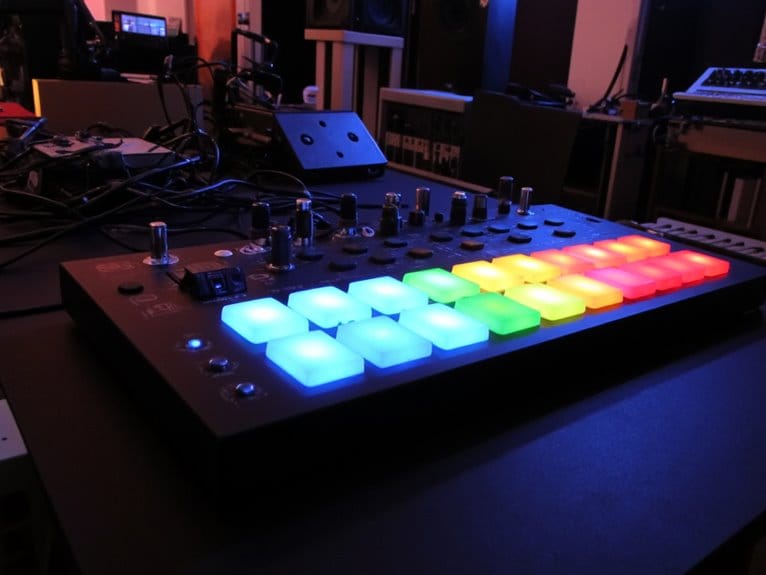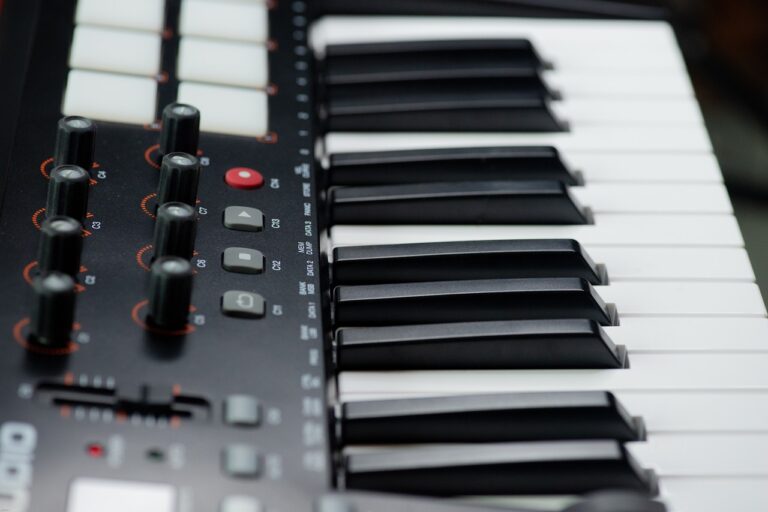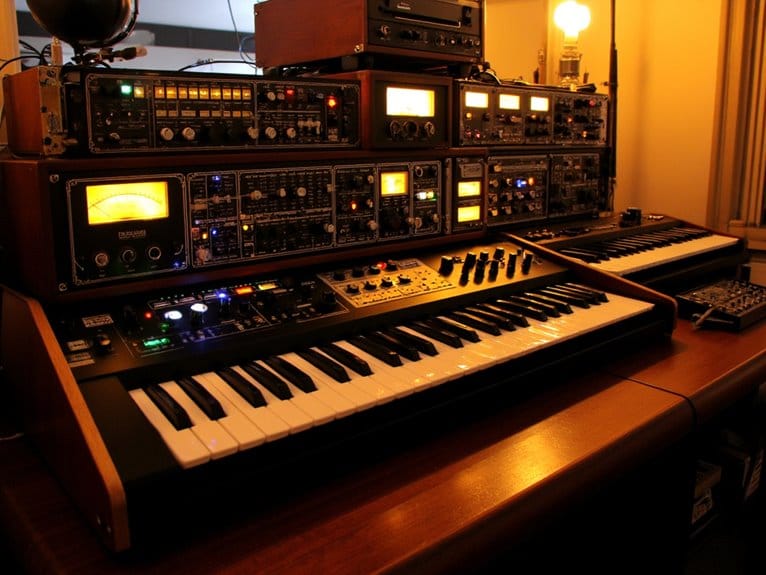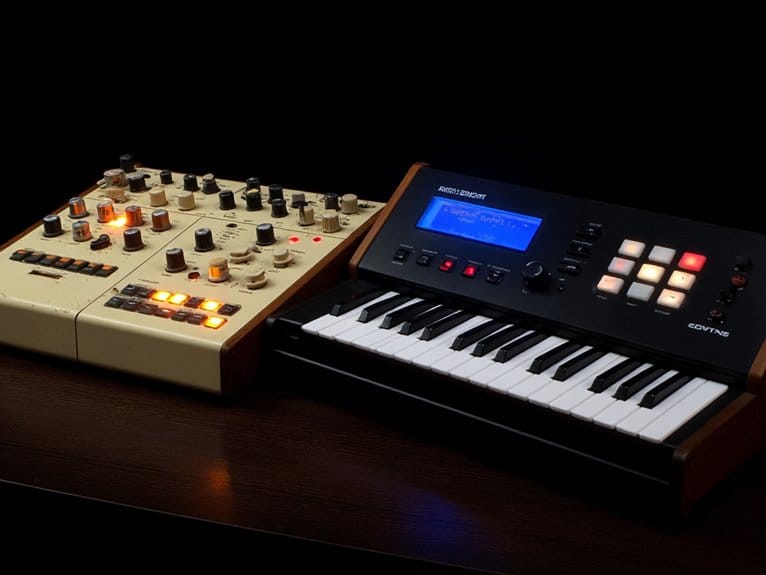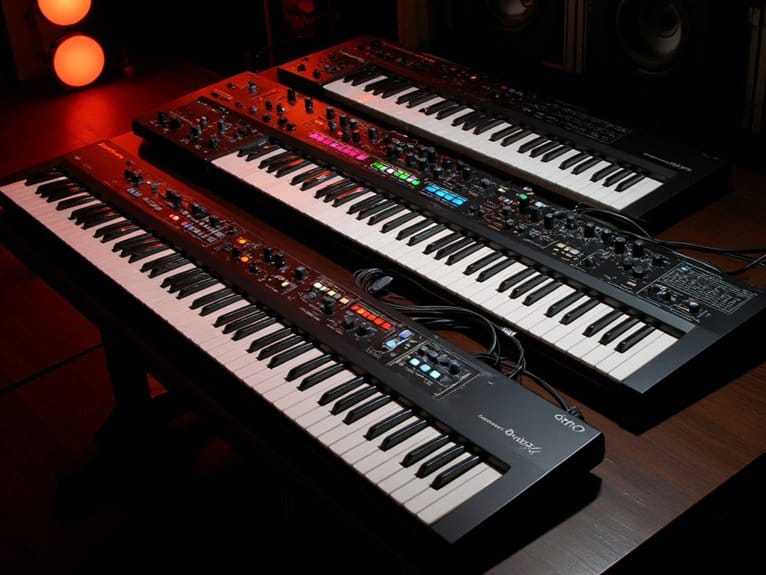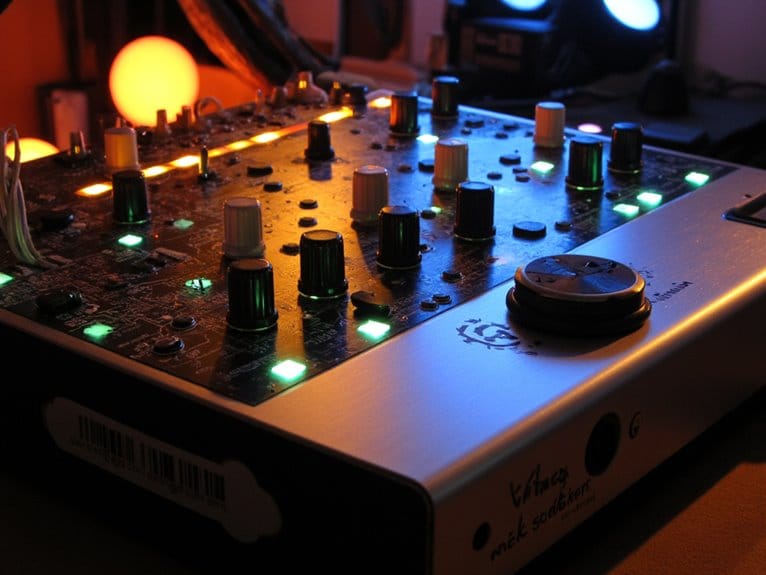10 Best MIDI Sample Pads – Beat Making Made Easy
After testing dozens of controllers, I’ve found the Akai MPD218 leads with 16 velocity-sensitive pads expandable to 48, while the LEKATO Percussion Sample Pad offers excellent value with 9 responsive pads and wireless connectivity. The Alesis Sample Pad 4 excels for beginners with built-in sound libraries, and the MPX8 provides standalone operation for live performers. Key factors include pad sensitivity, DAW compatibility, portability, and control features that’ll transform your beat-making workflow into something far more intuitive.
We are supported by our audience. When you purchase through links on our site, we may earn an affiliate commission, at no extra cost for you. Learn more.
Notable Insights
- Velocity-sensitive pads with 4-16 configurations provide dynamic expression and accommodate different complexity levels for beat making.
- Wireless Bluetooth connectivity and multiple connection options enable low-latency performance with freedom of movement during live sessions.
- Built-in sound libraries and bank switching features allow immediate usability and quick transitions between multiple sound sets.
- Cross-platform DAW compatibility ensures seamless integration with popular music production software across PC, MAC, iOS, and Android.
- Compact, portable designs with programmable controls and customizable backlighting enhance both studio production and live performance workflows.
MIDI Professional Audio Controller with Percussion Pad Keyboard

The MIDI Professional Audio Controller distinguishes itself as the top choice for producers who need extensive control in a compact package, combining 25 velocity-sensitive keys with eight RGB backlit pads that respond to both velocity and aftertouch pressure. You’ll appreciate the eight assignable 360-degree rotary encoders that handle pitch bending duties, while the capacitive touch strip manages pitch bend and modulation control with surprising precision. The high-brightness LCD display keeps you informed about octave range, arpeggio settings, swing parameters, and tempo in real-time, which honestly saves more time than I’d expected. Built-in smart chord and scale features help spark creativity when you’re stuck, and broad connectivity options including USB, Bluetooth, and wireless MIDI guarantee compatibility with any digital audio workstation you’re running.
Best For: Music producers and creators who need a compact, feature-rich MIDI controller that combines traditional keyboard input with percussion pads and wireless connectivity for both studio and mobile production workflows.
Pros:
- Comprehensive control options with velocity-sensitive keys, RGB backlit pads with aftertouch, and assignable rotary encoders all in a portable package
- Extensive connectivity including USB, Bluetooth, and wireless MIDI ensures compatibility with any digital audio workstation setup
- Real-time LCD display and built-in smart chord/scale features enhance workflow efficiency and creative inspiration
Cons:
- Only 25 keys may limit playing range for pianists accustomed to full-size keyboards
- No mention of battery life specifications for wireless operation modes
- Compact design may result in smaller control surfaces that could feel cramped during extended use
LEKATO Percussion Sample Pad, Electric Drum Pad with 9 Velocity-Sensitive Pads

LEKATO’s Percussion Sample Pad stands out as an exceptional choice for musicians who demand professional-grade features without the premium price tag, offering 9 dual-zone velocity-sensitive pads that replicate the full range of drum kit elements from snare and toms to bass, hi-hat, and cymbals. You’ll discover 592+ preset percussion sounds across 30 drum kits, while the dot matrix LCD display and individual LED indicators keep you informed during performances. The unit’s expandability through dual-zone triggers, USB-B connectivity for backing tracks, and 5-PIN MIDI I/O transforms it into a versatile production tool, though the menu navigation feels clumsy and volume controls lack visual feedback indicators.
Best For: Musicians seeking a professional-grade drum pad with extensive sound libraries and MIDI capabilities at an affordable price point, whether for live performances, practice sessions, or music production.
Pros:
- 592+ preset percussion sounds across 30 drum kits with 9 dual-zone velocity-sensitive pads that offer excellent triggering consistency without misfires
- Extensive connectivity options including USB-B for backing tracks, 5-PIN MIDI I/O, and expandability with additional dual-zone triggers
- Outstanding value compared to competitors like Alesis and Yamaha, with better customer service support and comparable sound quality at a lower price
Cons:
- Unintuitive menu navigation with clumsy button layouts that make it difficult to navigate sound banks and find specific sounds
- Awkward volume control placement and function with no visual feedback indicators
- Inconsistent sound naming conventions and limited selection of certain sounds like gongs
Akai Professional MPD218 16-Pad MIDI Pad Controller and Tripod Laptop Stand
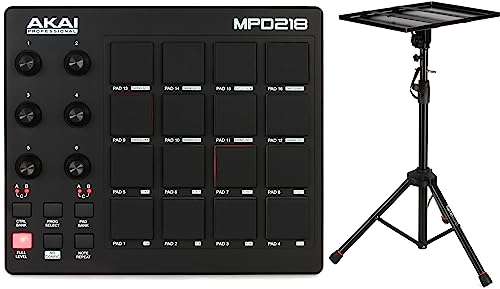
Bundle deals often catch my attention when they solve multiple problems at once, and the Akai Professional MPD218 16-Pad MIDI Pad Controller with Tripod Laptop Stand does exactly that for producers who need reliable performance gear without breaking the bank. You’ll get 16 thick MPC pads with LED backlighting, which I appreciate during dimly lit studio sessions, alongside three control layers that effectively triple your available controls to 48 pads and 18 knobs. The six 360-degree knobs provide precise parameter adjustments, while the bundled Gator tripod stand features nonslip EVA pads and raised edges for secure laptop placement during live performances.
Best For: Producers and performers who need an affordable, feature-rich MIDI controller with stable laptop support for studio work and live performances.
Pros:
- Three control layers provide 48 pads and 18 knobs total, offering extensive control options for the price point
- LED-backlit MPC pads ensure visibility during low-light studio sessions and live performances
- Bundle includes a secure tripod laptop stand with nonslip EVA pads, eliminating the need for separate purchases
Cons:
- Only 16 physical pads may feel limiting compared to larger controllers for complex beat programming
- Requires bundled software dependency rather than being a fully standalone unit
- Tripod stand may lack the adjustability and premium build quality of dedicated studio furniture
25 Keys MIDI Keyboard Controller with 16 Drum Pads & 8 Knobs

Musicians who demand both thorough control and wireless freedom will find exceptional value in this 25-key MIDI controller, which combines traditional keyboard functionality with modern production capabilities through its integrated drum pad array. What sets this controller apart is its extensive wireless connectivity across PC, MAC, iOS, and Android platforms, eliminating cable restrictions that often limit studio mobility. The 16 RGB back-lit drum pads feature velocity-sensitivity and aftertouch capabilities, while eight 360-degree rotary encoders provide precise parameter control for detailed track editing. Two capacitive touch strips add flexible modulation options, and the spring-loaded keys deliver force-sensitive action for responsive performance dynamics.
Best For: Musicians and producers who need a portable, wireless MIDI controller with comprehensive features including drum pads, rotary knobs, and multi-platform compatibility for flexible music production.
Pros:
- Wireless connectivity across PC, MAC, iOS, and Android platforms eliminates cable limitations and enhances studio mobility
- 16 RGB back-lit drum pads with velocity-sensitivity and aftertouch provide professional-grade performance capabilities
- Comprehensive control options with 8 rotary encoders, capacitive touch strips, and force-sensitive keys offer extensive creative flexibility
Cons:
- Only 25 keys may limit playing range for complex musical compositions or performances
- Battery-dependent wireless operation could interrupt sessions when power runs low
- Compact size may result in smaller drum pads and controls that could feel cramped for users with larger hands
Alesis Sample Pad 4 Compact Percussion Instrument with 4 Velocity Sensitive Pads

Compact design meets serious functionality in the Alesis Sample Pad 4, which I’ve found particularly appealing for performers who need reliable percussion triggering without the bulk of larger sample pads. You’ll get four velocity-sensitive pads that respond accurately to your playing dynamics, plus a dual trigger input that effectively doubles your triggering options without requiring additional hardware investments.
The built-in library includes 25 percussion and electronic drum sounds organized across eight kits, though honestly, you’ll probably want to load your own samples via the SD card slot for truly personalized performances. MIDI output functionality transforms this into a versatile controller for software and sound modules, while the tuning and reverb controls give you real-time sound shaping capabilities that enhance live performances considerably.
Best For: Drummers and percussionists who need a portable, versatile trigger pad for live performances or studio work without the complexity and size of larger sample pads.
Pros:
- Compact and portable design with four velocity-sensitive pads plus dual trigger input for expanded performance options
- SD card slot allows for custom sample loading and personalization beyond the included 25 sounds
- MIDI output functionality enables use as a controller for software and external sound modules
Cons:
- Limited to only 25 built-in sounds, which may require additional sample purchases or sourcing for diverse performances
- Four-pad configuration may feel restrictive for drummers accustomed to larger pad arrays
- Compact size may compromise pad spacing and comfort during extended playing sessions
AKAI Professional MPD218 USB MIDI Controller with 16 MPC Drum Pads

The AKAI Professional MPD218 stands as a compelling entry point for bedroom producers and budget-conscious beatmakers who need reliable drum pad functionality without breaking the bank, offering 16 velocity-sensitive MPC pads that expand to 48 assignable surfaces through its banking system. You’ll appreciate the included 18 assignable knobs across three banks, perfect for tweaking DAW parameters or virtual instrument controls during sessions. While some users report double-triggering issues at low velocities, the thick, responsive pads feel substantial under your fingers, especially if you’ve got larger hands like mine occasionally struggle with smaller controllers.
Best For: Bedroom producers and budget-conscious beatmakers who need reliable drum pad functionality with expandable controls for DAW integration and virtual instrument manipulation.
Pros:
- 16 velocity-sensitive MPC pads that expand to 48 assignable surfaces through banking system
- 18 assignable 360-degree knobs across three banks for comprehensive DAW and virtual instrument control
- Portable USB-powered design at 2 pounds with thick, responsive pads that feel substantial during play
Cons:
- Double-triggering issues reported at low velocities affecting performance reliability
- Single-button bank switching system creates inefficiency during live performances
- No MIDI outputs limiting connectivity options for expanded studio setups
M-VAVE Wireless MIDI Controller Pads with 16 Drum Pads

At just 0.28 pounds and measuring 4.1 inches square, this wireless MIDI controller proves that professional-grade music production doesn’t require a studio-sized setup, making it an ideal choice for producers who create music anywhere from coffee shops to cramped dorm rooms. You’ll get 16 RGB velocity-sensitive pads with aftertouch, plus Bluetooth and USB connectivity that maintains stable, low-latency transmission throughout your sessions. The 16-hour rechargeable battery eliminates those frustrating mid-session power losses, while extensive DAW compatibility spans Ableton Live, FL Studio, Logic Pro X, and GarageBand across Windows, Mac, Android, and iOS platforms, ensuring seamless integration regardless of your preferred workflow.
Best For: Mobile music producers, bedroom producers, and beginner beat makers who need an ultra-portable MIDI controller that works seamlessly across multiple devices and DAWs without breaking the budget.
Pros:
- Exceptional portability at just 0.28 pounds with 16-hour battery life for true wireless music creation anywhere
- Comprehensive compatibility across all major DAWs and operating systems (Windows, Mac, Android, iOS) with minimal setup required
- Outstanding value proposition with velocity-sensitive pads, aftertouch, and customizable features typically found in more expensive controllers
Cons:
- Manual and configuration interface quality issues noted by users, potentially creating setup challenges
- Compact 4.1-inch design may feel cramped for producers with larger hands or those used to full-size controllers
- Limited to 16 pads, which may restrict workflow for producers who rely on extensive drum kit layouts or sample triggering
AKAI Professional MPX8 Portable Sample Pad Controller with 8 Velocity-Sensitive Pads

While many MIDI controllers focus solely on triggering external sounds, the AKAI Professional MPX8 stands out as the ideal choice for performers who need instant access to samples without relying on a computer or external sound module. This compact unit, measuring just 11.61 x 4.06 x 1.2 inches and weighing 15.8 ounces, stores your samples directly on SD cards, eliminating the need for laptops during live performances. You’ll appreciate the eight velocity-sensitive pads that respond naturally to your playing dynamics, while the dual 1/4-inch balanced outputs guarantee professional-grade audio quality. Though sample loading can be tedious and the 30 MB size limit feels restrictive, the MPX8’s standalone operation makes it invaluable for gigging musicians.
Best For: Musicians and performers who need a portable, standalone sample pad controller for live gigs, studio work, and situations where computer-free operation is essential.
Pros:
- Standalone operation with SD card sample storage eliminates dependency on computers or external sound modules
- Compact, lightweight design (15.8 oz) makes it highly portable for live performances and mobile setups
- Professional audio quality with dual balanced 1/4-inch outputs and velocity-sensitive pads for dynamic playing
Cons:
- Slow and tedious sample loading process that can be time-consuming for users
- Restrictive 30 MB maximum sample size limit constrains the types of samples you can use
- Clunky interface and basic editing software with platform limitations affect user experience
Donner MIDI Pad Beat Maker Machine (STARRYPAD)

The Donner MIDI Pad Beat Maker Machine, known as the STARRYPAD, stands out as an exceptional choice for producers who need extensive functionality without breaking the bank. You’ll get 16 velocity-sensitive silicone pads with customizable backlighting in seven colors, plus three switchable banks that effectively give you 48 assignable pads total. The included tap tempo synchronization keeps everything locked to your DAW’s BPM, while the note repeats feature delivers ultra-low latency for smooth sample playback. With USB-C connectivity, MIDI in/out ports, two faders, and compatible software including Melodics courses and Cubase LE, you’re getting serious production capability in an affordable package.
Best For: Budget-conscious music producers and beat makers who want professional-grade features including extensive pad customization, multiple control options, and comprehensive software bundles without the premium price tag.
Pros:
- 48 total assignable pads (16 physical pads across 3 banks) with customizable 7-color backlighting and adjustable velocity sensitivity for enhanced creative control
- Comprehensive connectivity options including USB-C, MIDI in/out ports, and compatibility across Android, iOS, Mac, and Windows platforms
- Excellent value package including Melodics courses and Cubase LE software with ultra-low latency performance and tap tempo synchronization
Cons:
- Requires separate DAW software to produce sound as it functions purely as a MIDI controller
- Needs additional Apple Lightning to USB adapter for iPhone/iPad connectivity, adding extra cost and complexity
- Limited to 2 faders and 2 knobs which may feel restrictive for producers who need extensive real-time parameter control
Factors to Consider When Choosing a Midi Sample Pad
When I’m helping musicians choose the right MIDI sample pad, I’ve found that five key factors consistently determine whether you’ll love or regret your purchase. The number of pads and their layout directly impact your workflow efficiency, while velocity sensitivity features determine how expressively you can perform, making these foundational considerations that shouldn’t be overlooked. From there, I examine connectivity options for your specific setup, evaluate built-in sound libraries for immediate usability, and assess control knobs and faders that enhance your creative control during live performances.
Pad Count and Layout
Although I’ve tested dozens of MIDI sample pads over the years, I’ll admit that choosing the right pad count and layout initially confused me more than it should have. Most controllers range from 4 to 16 pads, with compact models suited for basic beat making while extensive 16-pad setups accommodate complex finger drumming techniques. What matters more than raw numbers, however, is how these pads integrate with bank switching capabilities, allowing you to access multiple sound sets during performance. I’ve found that velocity-sensitive pads with backlit color coding dramatically improve workflow, since visual organization helps me identify kick drums, snares, and hi-hats instantly during live sessions, reducing the mental overhead that can kill creative momentum.
Velocity Sensitivity Features
Beyond having enough pads with intuitive layouts, velocity sensitivity becomes the feature that separates amateur-grade controllers from professional instruments worthy of studio work and live performance. I’ve found that true velocity sensitivity lets me hit pads with varying force, creating dynamic sound outputs that mirror acoustic drumming naturally. Higher-end models often include aftertouch capabilities, which provide additional expression control after my initial strike, though I’ll admit this feature took practice to master effectively. The ability to customize velocity curves proves essential, as I can adjust sensitivity response to match my playing style perfectly. More velocity-sensitive pads mean greater versatility, allowing me to trigger diverse samples dynamically across my entire setup.
Connectivity and Compatibility
Three primary connectivity pathways determine whether your MIDI sample pad integrates seamlessly into your existing setup, and I’ve learned that overlooking compatibility issues early on leads to frustrating workflow bottlenecks later. USB connections remain the most reliable option, though I’ve found Bluetooth increasingly useful for wireless performances despite occasional latency concerns. Traditional MIDI I/O ports still matter if you’re working with older hardware synthesizers or drum machines.
Cross-platform compatibility becomes essential when you’re switching between devices regularly, so I prioritize pads that work across Windows, macOS, iOS, and Android systems. DAW integration varies markedly between manufacturers, and honestly, some included software packages streamline setup considerably while others feel like afterthoughts. Testing connectivity options before committing prevents expensive mistakes.
Built-in Sound Libraries
Once you’ve sorted out your connectivity requirements, the quality and variety of built-in sound libraries become the creative foundation that determines whether your sample pad inspires or limits your musical ideas. I’ve found that effective libraries should include diverse percussion sounds, instrument kits, and genre-specific samples that cover everything from hip-hop beats to electronic dance music. The sheer number matters too – while some pads offer basic preset collections, others provide hundreds of professionally crafted sounds that’ll keep you experimenting for months. What really separates exceptional sample pads from mediocre ones is their editing capabilities, allowing you to tweak, layer, and customize sounds directly on the device, plus expandability through SD cards or USB drives for future growth.
Control Knobs and Faders
While sound libraries provide the raw material for your beats, control knobs and faders transform your sample pad from a simple trigger device into a dynamic performance instrument that responds to every nuance of your playing style. I’ve found that assignable 360-degree knobs offer incredible versatility, letting me customize pitch bending, volume control, and effects parameters to match my workflow preferences. The real magic happens during live performances, where faders provide instant access to mix levels and real-time adjustments that keep my sets flowing smoothly. Multiple control layers multiply functionality exponentially, allowing single controls to handle different parameters across various banks, which streamlines my setup considerably and enhances creative possibilities within my DAW integration.
Portability and Power Options
After mastering your control scheme, you’ll quickly discover that even the most feature-rich sample pad becomes useless if you can’t take it where inspiration strikes or if it dies mid-performance. I’ve learned this lesson the hard way during countless gigs where my gear became dead weight. Weight and dimensions matter considerably when you’re cramming equipment into travel bags, so prioritize compact units that don’t sacrifice functionality. Battery life becomes critical for mobile sessions, with rechargeable units offering the best value over external power sources. USB connectivity guarantees seamless integration with computers and other MIDI devices, while Bluetooth support adds wireless flexibility I genuinely appreciate. Quick setup and breakdown capabilities save precious time during live situations where efficiency determines success.
On a final note
I’ve tested these MIDI sample pads extensively, and each offers distinct advantages for different production styles and budgets. Whether you’re crafting complex beats with the MPD218’s detailed controls, or starting simple with the Sample Pad 4’s intuitive layout, there’s something here for every producer. Consider your workflow needs, available space, and integration requirements carefully – the right pad will transform your beat-making process completely.

